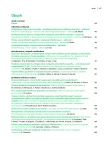Extraadrenal paraganglioma
Authors:
Zuzana Teliarová 1; Jana Kollerová 1; Peter Jackuliak 1; Ján Breza 2; Juraj Payer 1
Authors‘ workplace:
V. interná klinika LF UK a UN Bratislava, Slovenská republika, prednosta prof. MUDr. Juraj Payer, PhD., FRCP
1; Urologická klinika LF UK a UN Bratislava, Slovenská republika, prednosta prof. MUDr. Ján Breza, DrSc.
2
Published in:
Vnitř Lék 2014; 60(5-6): 514-519
Category:
Case Report
Overview
Various symptoms may be present in pheochromocytoma and paraganglioma. The tumor can imitate numbers of diseases and often leads to misdiagnosis. Current advances in laboratory techniques (determination of free plasma metanephrines), tumor localization (using positron emission tomography) and surgery techniques together with better understanding of pathophysiology and genetics (role of subunit B of succinate dehydrogenase) lead to earlier diagnosis, changes in strategy and treatment options. Authors introduce case report of retroperitoneal paraganglioma in 59 years old patient. In conclusion, interdisciplinary cooperation in diagnosis and treatment was successful.
Key words:
diagnosis – paraganglioma – pheochromocytoma
Sources
1. Elder E, Elder G, Larsson C. Pheochromocytoma and functional paraganglioma syndrome: no longer the 10% tumor. J Surg Oncol 2005; 89(3): 193–201.
2. Pacák K. Feochromocytóm. Galén: Praha 2008. ISBN 978–80–7262–519–2.
3. Daub KF. Pheochromocytoma: challenges in diagnosis and nursing care. Nurs Clin North Am 2007; 42(1): 101–111.
4. Pacák K, Lazúrová I et al. Endokrinní nádory nadledvin v současné klinické praxi. Galén: Praha 2011; 1: 131–133. ISBN 978–80–7262–819–3.
5. Lenders JW, Eisenhofer G, Mannelli M et al. Pheochromocytoma. Lancet 2005; 366 (9486): 665–675.
6. Amar L, Servais A, Gimenez-Roqueplo AP et al. Year of diagnosis, features at presentation, and risk of recurrence in patients with pheochromocytoma or secreting paraganglioma. J Clin Endocrinol Metab 2005; 90(4): 2110–2116.
7. Neumann HP, Bausch B, McWhinney SR et al. Germ-line mutations in nonsyndromic pheochromocatoma. N Engl J Med 2002; 346(19): 1459–1466.
8. Mantero F, Terzolo M, Arnaldi G et al. A survey on adrenal incidentaloma in Italy. Study Group on Adrenal Tumors of the Italian Society of Endocrinology. J Clin Endocrinol Metab 2000; 85(2): 637–644.
9. Manger WM, Gifford RW. Pheochromocytoma. J Clin Hypertens (Greenwich) 2002; 4(1): 62–72.
10. Pacak K, Linehan WM, Eisenhofer G et al. Recent advances in genetics, diagnosis, localization and treatment of pheochromocytoma. Ann Intern Med 2001; 134(4): 315–329.
11. Pacak K, Ilias I, Adams KT et al. Biochemical diagnosis, localization and management of pheochromocytoma: focus on multiple endocrine neoplasia type 2 in relation to other hereditary syndromes and sporadic forms of the tumour. J Intern Med 2005; 257(1): 60–68.
Labels
Diabetology Endocrinology Internal medicineArticle was published in
Internal Medicine

2014 Issue 5-6
Most read in this issue
- Adult-onset Still’s disease – a difficult path to diagnosis through fever and effusions of unknown origin
- Purple urine bag syndrome – rare but substantial symptom of urinary infection
- Sentinel lymph node in malignant melanoma
- Diffuse Idiopathic Skeletal Hyperostosis
